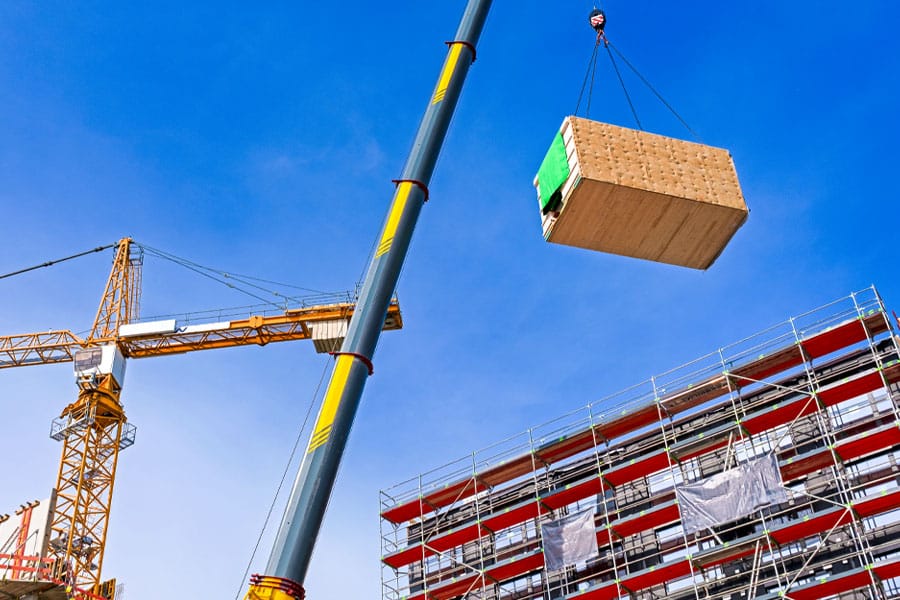The construction sector is increasingly turning to technological innovation to tackle its challenges. Whether addressing safety or quality issues, looking at more efficient design routes, testing new methods to improve building performance or seeking opportunities to reduce carbon emissions in both construction and operation, a raft of solutions are available on the market.
There are two main routes to achieving this: digitising traditional practices to make them more effective or developing completely new approaches. Modern methods of construction (MMC) and offsite construction fall into the latter, with a focus on using manufacturing techniques and standardisation to achieve better project outcomes.
And while there is much focus on transforming existing processes with technology, software solutions are being built in from the start when it comes to MMC.
Modern methods of construction defined
MMC cover production techniques that see elements of a building, or in some cases complete units, created in off-site factory settings, where quality thresholds and worker safety can be better monitored. These include modular, volumetric, pods, panelised systems, sub-assemblies and prefabricated units.
According to the UK’s National House Building Council Federation, MMC “is a wide term, embracing a range of offsite manufacturing and onsite techniques that provide alternatives to traditional house building.”
The NHBC Foundation says MMC applications range from whole homes being constructed from factory-built volumetric modules through to the use of innovative techniques for laying concrete blockwork onsite.
A champion of MMC in the UK is Mark Farmer, the chief executive of construction consultancy Cast and the author of an influential call-to-arms for the sector, “Modernise Or Die,” a report published in 2016 which urges the industry to embrace new methodologies and put in place the skill sets necessary to take the construction sector into the 21st century.
Farmer said in 2020 that the UK government should ramp up the modular construction of 75,000 homes per year by 2030, which he said could push the use of off-site construction and MMC to a tipping point of wider industry acceptance and move the modular sector beyond its current “cottage industry” status.
The digital side to MMC
The adoption of MMC across the industry has the potential to drive a more efficient, safer and sustainable sector. And with problems around skills shortages and the rising cost of materials, it could help to create a very different construction industry, with an increase in product innovation and a manufacturing-based approach, as well as opening the door to a more diverse workforce.
Offsite manufacturing techniques need digital practices at their core. This can cover a range of needs, from efficient ways to design and collaborate, improved quality assurance during production, and ongoing management of assets (both in digital and physical form).
Get this right, and the industry will be able to meet the rising demand in sectors such as housing, health care and education at scale and improve the way we build, delivering greater value for communities and the taxpayer.
An offsite approach is endorsed by government, with the Construction Playbook calling for greater collaboration, carbon reduction and digitalisation via this route. The current consultation on the Product Platform Rulebook, via the Construction Innovation Hub, also shows that this is the future direction of travel.
Tech and MMC—a perfect match
An area where MMC goes hand in hand with software solutions is that designs can be tested digitally and optimised in virtual and pre-production environments before going to site. The repeatability and standardisation of a manufacturing-led method makes it perfect for this approach.
If data is accurately collected and collated during this process, it allows for greater measurement and validation when it comes to performance too, increasing our understanding of how built assets operate when comparing design and reality.
This means that we should see more effective and precise resource planning to avoid material wastage, reducing both the need and cost for labour and equipment. This in turn reduces the carbon footprint of the construction process in tandem with the offset that can be achieved from an efficient offsite manufacturing process.
Bringing people together with software
By using MMC in combination with software solutions such as Bluebeam, project teams can communicate and collaborate in real time across multiple locations and preserve important project data throughout the process from initial design through to the occupation and management of the final building.
This boosts transparency, encourages shared learning and provides an audit trail for every step of the project, helping with compliance. It makes it much more likely that potential risks and issues are identified early on, avoiding costly delays or mistakes and resulting in better-value, higher-quality projects.
It also helps organisations to achieve a “golden thread” of information through fully traceable digital records. A key recommendation from the Hackitt Report and part of the Building Safety Act, the golden thread is based upon organisations keeping accurate records of the products and material specifications used on projects. This helps with ongoing maintenance, including repair and replacement, builds a deeper understanding of performance and allows for greater risk management should any problems occur with products or if guidance or legislation changes.
Digital construction solutions are vital then when it comes to safeguarding the future of the built environment and its occupants, allowing construction professionals to comply with the legal requirements for improved levels of asset information.
A model for the future of construction
The construction sector needs to change the way it procures to support investment in MMC and digitalisation if it wants to tackle rising costs and supply chain disruption while increasing collaboration, value and sustainability.
By fully using and embedding the range of digital technologies in combination with MMC, it is possible to standardise the industry’s approach to generating and classifying data, data security and data exchange. Recent momentum must continue to build on the uptake and investment of digital technology, strategies and skills to deliver rapid, high-quality, low-carbon buildings that will stand the test of time.
To find out how Bluebeam can support you, visit: https://www.bluebeam.com/uk/landing/go-digital.











